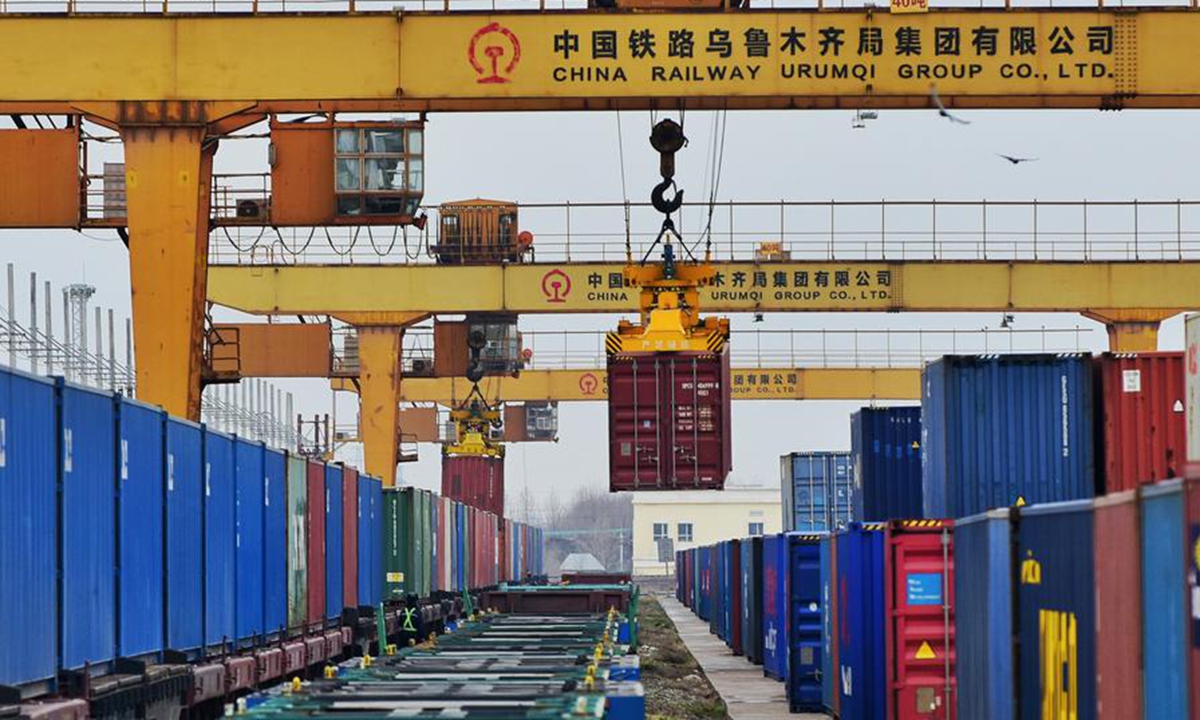
A container of China-Europe freight train is lifted at Horgos Port in Horgos, northwest China's Xinjiang Uygur Autonomous Region, Jan. 15, 2024. (Photo by Bai Fengliang/Xinhua)
The Chinese government has issued an action plan to cut logistics costs to boost economic efficiency, targeting a reduction in the ratio of social logistics costs to GDP to around 13.5 percent by 2027, the Xinhua News Agency reported Wednesday.
Key goals include breakthroughs in integrated transport reforms, optimizing freight transport structure, increasing the share of railway freight volume and railway freight turnover to 11 percent and 23 percent, and boosting growth in port container rail-water intermodal transport. The plan also seeks to foster globally competitive logistics firms, enhance the national logistics hub system, and establish a unified, efficient, and competitive logistics market.
"The plan is crucial for building a unified national market by removing barriers and reducing transaction costs. It will play a key role in driving high-quality economic growth, especially in advancing high-end manufacturing," Li Chang'an, a professor at the Academy of China Open Economy Studies at the University of International Business and Economics told the Global Times on Wednesday.
Li noted that these actions are crucial for improving global supply chains and advancing China's high-quality opening-up.
"It also plays a key role in optimizing China's international supply chain. For instance, by setting up warehouses and ports abroad and improving the operation of China-Europe freight trains, cross-border transport efficiency is significantly enhanced," said Li, adding that measures such as avoiding double taxation help Chinese products reach international markets faster.
The plan highlights the need for open logistics data sharing, and integration of public resources from transport and customs sectors. It emphasizes interconnectivity, supports data integration for businesses, and will promote sustainable models. Additionally, it calls for stronger data security, improved authorization systems, and market-based circulation of enterprise logistics data.
The plan outlines a logistics efficiency initiative for the "new three" exports: new-energy vehicles (NEVs), lithium-ion batteries, and photovoltaic products. It emphasizes upgrading port storage facilities, facilitating smoother exports, and setting technical standards for large storage batteries and photovoltaic modules. Key measures include enhancing safety management protocols for lithium battery transport, expanding roll-on/roll-off ("ro-ro") port capabilities, promoting the development of river ro-ro vessels, and exploring containerized transport using electric vehicles to streamline domestic and cross-border logistics.
The plan focuses on developing the international supply chain by supporting the establishment of logistics hubs in key regions to enhance trade in bulk goods, NEVs, and cold-chain products. It encourages large businesses to collaborate with logistics firms on shared overseas warehouses and services, while optimizing the scheduling and capacity of China-Europe freight trains.
The plan also focuses on upgrading logistics infrastructure and advancing digital transformation. It calls for innovation in key technological areas like big data, 5G, and BeiDou navigation, while integrating artificial intelligence (AI) into modern logistics. Priority will be given to modernizing traditional infrastructure and building smart highways, ports, hubs, and logistics parks, while promoting technologies such as autonomous vehicles, ships, drones, warehouses, and loading systems, and enhancing the integration of smart warehousing, distribution, and transport with digital twin technology.
"Integrating AI with modern logistics not only enhances customs efficiency but also enables precise point-to-point delivery, reducing time costs and offering significant benefits," Li said.
Li noted that the plan promotes emerging sectors such as platform economy, low-altitude economy, and autonomous driving. Developing the platform economy helps match supply with demand, easing market bottlenecks, while low-altitude and autonomous technologies improve logistics flow.
On November 9, the Ministry of Transport and the National Development and Reform Commission issued a notice on the release of the action plan for reducing costs and improving efficiency in transportation and logistics.
The China Federation of Logistics and Purchasing reported at the end of October that total logistics costs in the first three quarters of 2024 reached 13.4 trillion yuan ($1.85 trillion), up 2.3 percent year-on-year. It also accounted for 14.1 percent of GDP, down 0.1 percentage points from the first half of the year and 0.2 percentage points year-on-year.




